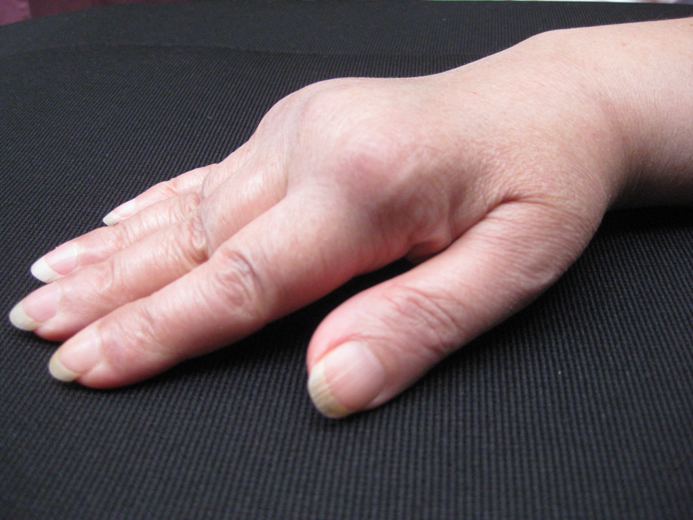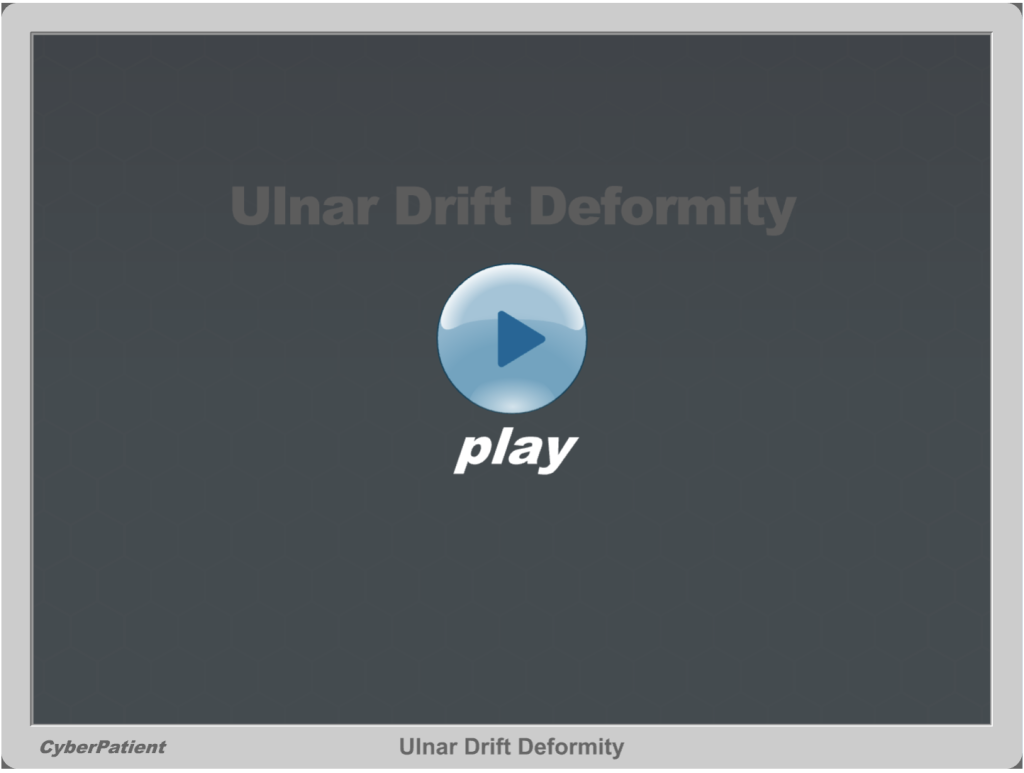Description #
Ulnar drift deformity (UDD) is a common hand deformity in patients with rheumatoid arthritis. UDD can develop early in the disease process and have significant impact on hand function and quality of life. It is crucial that health care professionals have a good understanding of the pathomechanics in order to properly assess and manage this hand deformity. This unit will cover:
- Pathomechanics of UDD
- Components of a RA hand assessment – key tests
- Hand Exercises for UDD
- Splinting for UDD
Learning Objectives #
On completion of this unit, you will be able to:
- Describe the pathomechanics of ulnar drift deformity (UDD) in rheumatoid arthritis (RA).
- Understand components of a RA hand assessment and be confident in performing key tests.
- Prescribe appropriate hand exercises for UDD.
- Understand the role of splinting for UDD.
- Understand joint protection principles for UDD.
Introduction #
Rheumatoid arthritis (RA) is a chronic, systemic, autoimmune disease characterized by symmetrical peripheral polyarthritis1. RA has the propensity to target the wrist and hands causing joint destruction and weakening of the periarticular structures leading to irreversible hand deformities2. 59% of individuals develop one or more hand deformities after 10 years of disease duration3. The presence of hand deformities is a predictor of disease severity and is correlated with a positive rheumatoid factor, active synovitis and disease duration3,4,5. Hand deformities, together with pain and decreased muscle force, can have significant functional consequences and impact quality of life6.
This unit will introduce you to one of the common hand deformities in RA: Ulnar drift deformity (UDD). It is recommended that you first read/view the materials in the “Recommended Reading/Viewing” section (see Content Navigation) before beginning this unit.

References:
- Carmona L, Cross M, Williams B, et al. Rheumatoid arthritis. J Best Pract Res Clin Rheumatol 2010:24:733-45.
- Cima SR, Barone A, Porto JM, et al. Strengthening exercises to improve hand strength and functionality in rheumatoid arthritis with hand deformities: a randomized controlled trial. Rheumatol Int.doi:10.1007/s00296-012-2447-8.
- Johnsson PM, Eberhardt K. Hand deformities are important signs of disease severity in patients with early rheumatoid arthritis. Rheumatology 2009;48:1398-1401.
- Madenci E, Gursoy S. Hand deformity in rheumatoid arthritis and its impact on the quality of life. Pain Clinic 2003;15:255-259.
- Eberhardt P, Malcus Johnson P, rydgren L. The occurence and significance of hand deformities in early rheumatoid arthritis. rheumatology 1991;30:211-213.
- Porter BJ, Brittain A. Splinting and hand exercises for three common hand deformities in rheumatoid arthritis: a clinical perspective. Curr Opin rheumatol 2012;24(2):215-221.
Ulnar Drift Deformity in Rheumatoid Arthritis #
Welcome to Ulnar Drift Deformity (UDD) in Rheumatoid Arthritis (RA) video lecture.This video will introduce you to:
- The basic pathomechanics of UDD
- Components of an RA hand assessment with focus on key tests
- Hand exercises for flexible UDD
- Splinting for UDD
- Joint protection principles for UDD

Click on the link below to view the lecture.
To further assist you with your understanding of UDD, be sure to view these additional resources available under the “Content Navigation” bar to the right of your screen.
- Animation: Pathomechanics of UDD
- Video demonstration: Key tests for UDD
- Animation: Splinting for UDD
Animation: Pathomechanics of UDD* #

Video Demonstration of Key Tests #
This video will review five tests that are commonly used for ulnar drift deformity. They are:
- The ulnar fovea sign
- The distal radioulnar joint (DRUJ) ballottement test (otherwise known as the piano key test)
- The bunnel-littler test
- The lumbrical tightness test
- The extensor tendon subluxation test
The first two tests are important because the more proximal joints, in this case the DRUJ, can cause instability and deformity inthe more distal joints [i.e. metacarpophalangeal joints (MCPJs)].
The next two tests are used to assess for intrinsic muscle tightness which, if tight, can contribute to volar subluxation at the MCPJs.
The last test is used to assess whether the sagittal bands can stabilize the extensor tendon centrally over the MCPJs to prevent, for example, abnormal ulnar deviation forces.
Although many of these tests lack research into their psychometric properties, these maneuvers, when performed properly by skilled clinicians and used in combination rather than in isolation, can be powerful clinical tools.
References:
- Aoki M, Moriya T, Iba Y, et al. Effect of triangular ligament tears on distal radioulnar joint instability and evaluation of three clinical tests: A biomechanical study. J Hand Surg 2009;34:219-223.
- Harrell P. Biomechanics of the hand. ARHP audioconference: June 16, 2005.
- Hoppenfeld S. Physical Examination of the Spine and Extremities. Norwalk: Appleton-Century-Crofts;1976. pp. 101-102.
- Mary Pack Arthritis Program (MPAP): Best practice recommendations for the management of ulnar drift deformity in rheumatoid arthritis. 2011.
- Shinohara T, Nakamura R, Suzuki M, et al. Extensor mechanism laxity at the metacarpal joint as identified by a new provocative test – predisposition to dislocation. J Hand Surg 2005;30B:79-82.
- Tay SC, Tomita K, Berger RA. The “ulnar fovea sign” for defining ulnar wrist pain – an analysis of sensitivity and specificity. J Hand Surg 2007;32A:438-444.
Animation: Splinting for UDD* #

Recommended Reading/Viewing #
- Mary Pack Arthritis Program: Best practice recommendations for the management of ulnar drift deformity in rheumatoid arthritis. 2011. Best_Practise_for_UDD_2011.pdf
- Porter BJ, Brittain A. Splinting and hand exercise for three common hand deformities in rheumatoid arthritis: a clinical perspective. Curr Opin Rheumatol 2012:24(2):215-221.
- The University of Ottawa, Faculty of Health Sciences, The Centre for e-learning centre, The Arthritis Society: Standardized Assessment of Joint Inflammation. www.arthritis.ca/saji.
References #
Abboud JA, Beredjiklian P, Bozentka DJ. Metacarpophalangeal Joint Arthroplasty in Rheumatoid Arthritis. J Am Acad Orthop Surg 2003;11:184-191.
Akhavani MA, Palcolog EM, Kang N. Muscle Hypoxia in rheumatoid hands: Does it play a role in ulnar drift? J Hand Surg Am 36(4):677-685, DOI:10.1016/j.jhsa.2011.01.035.
Aoki M, Moriya T, Iba Y, et al. Effect of triangular ligament tears on distal radioulnar joint instability and evaluation of three clinical tests: A biomechanical study. J Hand Surg 2009;34:219-223.
Beenaker KGM. Patterns of muscle strength loss with age in the general population and patients with a chronic inflammatory state. Ageing Research reviews 9 (2010) 431-436.
Bielefeld T. Unstable MCP joint in rheumatoid arthritis: anatomy, pathomechanics, and physical rehabilitation considerations. J Orthop sports Phys Ther 2005;35:502-520.
Biese J. Therapist’s evaluation and conservative management of rheumatoid arthritis in the hand and wrist. In: Mackin EJ, Callahan Ad, Skirven TM, et al., editors. Rehabilitation of the hand and upper extremity. 5th ed. St. Louis: Mosby Inc.;2002. pp. 1569-1582.
Bland MD, Beebe JA, Hardwick DD. Restricted active range of motion at the elbow, forearm, wrist, or fingers decreases hand function. J Hand Ther 2008;21:268-275.
Brewerton DA. Hand deformities in rheumatoid disease. Ann. Rheum. Dis. 1957;16:183-197.
Brosson S, Hilliges M, Sollerman C, et al. A six-week hand exercise programme improves strength and hand function I patients with RA. J Rehabil Med 2009;41:338-342.
Carmona L, Cross M. Williams B, et al. Rheumatoid arthritis. J Best Pract Res Clin Rheumatol 2010;24:733-45.
Cima SR, Barone A, Porto JM, et al. Strengthening exercises to improve hand strength and functionality in rheumatoid arthritis with hand deformities: a randomized, controlled trial. Rheumatol Int. DOI:10.1007/s00296-012-2447-8.
Eberhardt P, Malcus Johnson P, Rydgren L. The occurrence and significance of hand deformities in early rheumatoid arthritis. Rheumatology 1991;30:211-213.
Groth G, VanDeven KM, Phillips EC, et al. J Hand Ther 2001:14(1):23-29.
Harrell P. Biomechanics of the hand. ARHP audioconference: June 16, 2005.
Hoppenfeld S. Physical Examination of the Spine and Extremities. Norwalk: Appleton-Century-Crofts;1976. pp.101-102.
Horsten NC, Ursum J, Roorda LD, et al. Prevalence of hand symptoms , impairments and activity limitations in rheumatoid arthritis in relation to disease duration. J Rehabil Med. 2010;42:916-921.
Johnsson, PM, Eberhardt K. Hand deformities are important signs of disease severity in patients with early rheumatoid arthritis. Rheumatology. 2009;48:1398-1401.
Jones E, Hanly JG, Mooney R, et al. Strength and function in the normal and rheumatoid Hand. J Rheumatol 1991;18:1313-1318. Kennedy D, Jerosch-Herold C, Hickson M. The reliability of one vs. three trials of pain-free grip strength in subjects with rheumatoid arthritis. J Hand Ther. 2010;23(4):384-390.
Kuczynski K. The synovial structures of the normal and rheumatoid digital joints. Hand 1971;3:(1):41-54.
Madenci E, Gursoy S. Hand deformity in rheumatoid arthritis and its impact on the quality of life. Pain Clinic 2003;15:255-259.
Mary Pack Arthritis Program (MPAP): Best practice recommendations for the management of ulnar drift deformity in rheumatoid arthritis. 2011. Best_Practise_for_UDD_2011.pdf
Neuman DA. Joint deformity and dysfunction: A basic review of underlying mechanisms. Arthritis Care Res 1999;12(2):139-151.
Porter BJ, Brittain A. Splinting and hand exercises for three common hand deformities in rheumatoid arthritis: A clinical perspective. Curr Opin Rheumatol 2012:24(2):215-221.
Shinohara T, Nakamura r, Suzuki M, et al. Extensor mechanism laxity at the metacarpal joint as identified by a new provocative test – predisposition to dislocation. J Hand Surg 2005:30B;79-82.
Skirven T. Clinical examination of the wrist. J Hand Surg 1996; April-June:96-107.
Solgaard S, Kristiansen B, Jensen JS. Evaluation of instruments for measuring grip strength. Acta Orthop Scand 1984;55:569-572.
Tay SC, Tomita K, Berger RA. The “ulnar fovea sign” for defining ulnar wrist pain – an analysis of sensitivity and specificity. J Hand Surg 2007;32A:438-444.
Zilstra TR, Heijnsdijk-Rouwenhorst L, Rasker JJ. Arthritis Care Res 2004;51:947-951.
